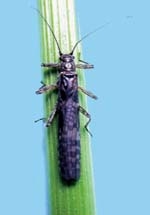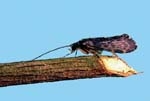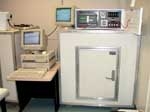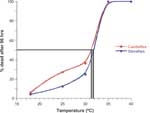PDF of this article (254 KB)

Brian Smith Kevin Collier
Healthy populations of aquatic insects need a suitable environment on the stream bank as well as in the water.

Adult Zelandoperla decorata (a stonefly).

Adult Hydrobiosis parumbripennis (a caddisfly).

Microclimate control chamber.

Diurnal temperature ranges over 96 hours used in the study.

Predicted LT50 for adult stoneflies and caddisflies.
The term “aquatic insects” is collectively applied to the nymphs or larvae (young stages) of insects that spend part of their life cycle in water. Thus, the definition is probably a bit of a misnomer, as most so-called aquatic insects leave the water as winged adults and spend what could arguably be the most important stage of their lives – the reproductive stage – on land.
As adults, the aquatic insects have essentially become terrestrial insects, but they still need to lay eggs in the stream. To do this, most must mate and, in many instances, feed. During this stage of their life cycle, riparian zones (stream-side vegetation) can provide a supply of food, sites for mating and completion of egg development, and also refuge from predators.
Survival of these adults is likely to be an extremely important factor regulating the size of aquatic insect populations, yet very little is known about the causes of mortality during the adult stage. Some adult insects, such as stoneflies and some caddisflies, can be relatively long-lived (up to 2–3 months in laboratory conditions). Therefore a suitable riparian environment is potentially very important.
Experiments with temperature
In a previous Water & Atmosphere article (6(4): 24–26), air temperature was reported to affect the longevity of adult stoneflies and, potentially, their ability to develop eggs. That study was run using constant temperatures, which do not accurately mimic daily changes that occur naturally. We therefore designed an experiment using temperatures that varied diurnally (over a 24-hour period). The aim was to examine the effects of different microclimate conditions on the survival of adults of the stonefly Zelandoperla decorata (left) and the caddisfly Hydrobiosis parumbripennis (left).
Using microclimate control chambers (see Water & Atmosphere 8(2): 5, and photo left), we set up a system to produce temperatures that were cooler in the morning, peaked around mid-afternoon, then gradually cooled overnight. Temperature regimes within and outside the insects’ normal environmental range were run using a constant baseline temperature of 12°C and maximum values of 18, 25, 30, 35 and 40°C, as shown in the graph left.
We collected well-developed stonefly nymphs and caddisfly pupae from streams. Both nymphs and pupae were reared at a constant 16°C until they emerged as winged adults. Once they had emerged, they were placed in their respective diurnal temperature treatments and provided with a sugar solution as food. Each day we counted how many live adults remained.
High air temperatures stressful
Insect survival is expressed as the time taken for half (50%) of the initial population to die, known as the LT50. The results from the previous constant-temperature study predic-ted that half of the adult stoneflies would have died within 4 days after exposure to a temperature of 22–23°C (a 96-h LT50). Our results using diurnally varying temperatures indicated that under these more natural circumstances the 96-h LT50 for adult stoneflies was a maximum daytime temperature of 31–32°C (see graph left), about 10°C above the calculated constant temperature LT50. We obtained a similar result with the caddisflies. The mortality rate of adult stoneflies and caddisflies increased rapidly when the diurnal maximum temperatures exceeded 30°C. With maximum temperatures greater than or equal to 35°C, all the adult insects had died within a few hours.
Dangerous living
Stress caused by high air temperatures may affect the ability of female aquatic insects to develop mature ovaries, potentially reducing population numbers. Initially we had expected adult stoneflies to be more sensitive than caddisflies to air temperature, as studies on stonefly nymphs have found that they are usually associated with cool-water habitats. The experiments showed that the stonefly and caddisfly species used were equally affected by high temperatures.
In some places, such as open-pasture sites sheltered from the wind, summer air temperatures can vary considerably through the day and can exceed the critical temperatures that would cause extreme stress and eventual death for the adult aquatic insects used in our experiment. Although some caddisfly species can be abundant around stream habitats where the air temperature may occasionally exceed 30°C, our results suggest they may be living on the edge in terms of adult environmental tolerances. In these more open sites, adult insects could perhaps reduce temperature-related stress and mortality by seeking out cooler places in the riparian grasses and shrubs, by remaining close to the stream, and by being active at night when temperatures are cooler.
On the other hand, measurements of temperature fluctuations in Waikato hill country native forest riparian zones have shown that the maximum temperature did not exceed 25°C, well below the estimated LT50 threshold for the stonefly and caddisfly species we used.
Our findings support the practice of planting or protecting streamside vegetation to manage riparian microclimate conditions for adult aquatic insects. Furthermore, our study raises questions about the potential impacts of global warming on the future distribution of some aquatic insects.
Teachers: this article can be used for Biology L8 A.O. 8.1a. See other curriculum connections at www.niwa.co.nz/pubs/wa/resources
Brian Smith and Kevin Collier are based at NIWA in Hamilton.
Further reading
Collier, K.J.; Smith, B.J. (2000). Interactions of adult stoneflies (Plecoptera) with riparian zones I. Effects of air and humidity on longevity. Aquatic Insects 22(4): 275–284.
Smith, B.J.; Collier, K.J. (2000). Interactions of adult stoneflies (Plecoptera) with riparian zones II. Diet. Aquatic Insects 22(4): 285–296.
